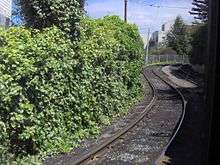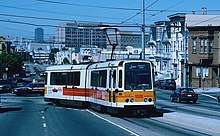J Church
The J Church is a Muni Metro light rail line in San Francisco, California, mainly serving the Noe Valley and Balboa Park neighborhoods, connecting them to downtown.
Route description

The line runs from Embarcadero Station in the Financial District to Balboa Park Station and the Balboa Park neighborhood near City College of San Francisco. The downtown portion of the line uses the Market Street subway, along with four other Muni Metro lines (K/T, L, M and N lines). The J exits the tunnel at Duboce Avenue along with the N Judah and turns onto Church Street. Between 18th and 20th Street, the line cuts through Dolores Park in a private right-of-way featuring a 9% grade, the steepest section of the Muni Metro.[3] After crossing 20th Street, it cuts across the blocks east of Church, around a steep hill and returns to Church Street at 22nd Street in Noe Valley. The J then follows Church to 30th Street, then to San Jose Avenue and Geneva. Between Randall and Cotter Streets, there is a right-of-way in the middle of San Jose Avenue. At the end of the line, the J loops around the Metro yard at San Jose and Geneva, alongside Balboa Park Station.
The J Church line stops at large stations for the downtown section of the route and at smaller stops on the rest of the line. Most of the smaller stops are designated by a sign on the sidewalk, while a few have concrete "islands" in the middle of the street next to the tracks that may provide access for wheelchairs.
While most other lines in the rail system can be run in two-car configurations, the J line is almost always run with a single car in order to accommodate the stops in the right-of-way, which are not long enough to have two light rail cars with open doors simultaneously.
Operation
The J Church begins service at 5 a.m. weekdays, 6 a.m. Saturdays and 8 a.m. Sundays and continues until 12:15 a.m. every night. Headways range from 7 to 15 minutes during the day, and 15 to 20 minutes at night.
Unlike the other Muni Metro lines, there is not a corresponding overnight Owl bus during the hours that rail service is not running. On weekends, J Church Bus service runs from 5am until the start of rail service. The bus line largely follows the rail line, but it uses surface streets to parallel sections where the rail line has dedicated rights-of-way.[4]
History
.jpg)
Track work on the J Church line was largely completed in 1916, and service from 30th Street and Church Street to Market Street and Van Ness Avenue on August 11, 1917.[5][2] Service was extended along Van Ness Avenue to Pine Street on August 29, 1917; this extension was discontinued on May 31, 1918, with service extended along Market Street to the Ferry Building the next day.[6] The new Transbay Terminal became the inner terminus for every other streetcar on January 15, 1939, with all service routed there after January 1, 1941.[6]
As part of the creation of the Muni Metro system, it was partially converted to modern light rail operation in 1981 – the last line to do so.[7][8] While many streetcar lines were converted to bus lines after World War II, the J Church avoided this due to the private right-of-way it uses to climb the steepest grades on Church Street, between 18th Street and 22nd Street.[9]
Extension to Balboa Park
The outer end of the line was originally at Church and 30th Streets, where streetcars used a wye to turn around. Studies to extend the line from its southern terminus had been made in the 1920s[5] and 1970's.[10] In 1990–91, the tracks were extended to the Balboa Park BART station and the Metro Center (Muni light-rail maintenance and operations base), giving J-line cars a much shorter connection to the yard than previously. The extension opened on August 31, 1991, but the 2.3-mile (3.7 km) new section was initially used only by light rail cars starting or ending their runs;[11] all-day J-line service was not extended along the new tracks until June 19, 1993.[12][13]

This trackage was laid along the Bernal Cut, the former right-of-way of the San Francisco & San Jose Railroad.[5]
This extension of the J-line to the Metro Center now also provides vintage F Market cars a connection to the adjacent Cameron Beach Yard, where they are stored when not in service. Occasionally J-Church streetcars use the siding at 30th and Church as a terminus during rush hours, or during irregular operations.
The 19th Avenue Platform & Trackway Improvement Project originally included pocket tracks to allow J Church trains to continue past Balboa Park with service to Stonestown. Due to community backlash, the compromise plan did not include the facilities necessary to run joint J-M service.[7]
The line was temporarily through-routed with the surface section of the K Ingleside line from June 25 to August 24, 2018 due to the Twin Peaks Tunnel shutdown.[14]
Future plans
In March 2014, Muni released details of the proposed implementation of their Transit Effectiveness Project (later rebranded MuniForward), which included a variety of changes for the J Church line intended to improve reliability and decrease travel times. The proposed changes included the removal of two stops (Liberty and Church and 30th Street), minor relocations of several other stops, construction of boarding islands and transit bulbs, and transit-only lanes on three blocks of Church Street, plus an increase in frequency from 9.5-minute headways to 8-minute headways during the morning peak.[15]
Most of the changes will be included in the proposed J Church Rapid Project. However, one element – dedicated transit/taxi lanes and left turn restrictions on Church Street between Duboce Avenue and 16th Street – was chosen for implementation as a pilot project to test its effectiveness. The red-painted dedicated center lanes (for use also by the 22-Fillmore bus) and turn restrictions were added in March 2013. The project proved to reduce travel time and improve reliability on both rail and bus, while not significantly increasing travel time in private automobiles.[16] Based on these positive results, the SFMTA Board made the changes permanent in June 2015.[17]
In November 2019, the SFMTA announced the J Church Improvement Project, which will make preliminary changes to the line while funding is sought for the full Rapid project. Church and 30th Street stop will be closed, safety modifications made to several stops, signage added to all stops, and a traffic light added at Cesar Chavez Street. A pilot program was to use a surface turnback on The Embarcadero in an effort to reduce terminal delays at Embarcadero station.[18]
On March 30, 2020, Muni Metro service was replaced with buses due to the COVID-19 pandemic.[19] Rail service is expected to return in August 2020, with the routes reconfigured to improve reliability in the subway. J Church service will run only on the surface between Balboa Park station and Church and Duboce station.[20]
With the completion of the proposed but unfunded M Ocean View Subway, the J Church would be re-routed to connect with the M Ocean View at a new four-track subway station at SF State. The J line would enter a new portal on 19th Avenue near Monticello Street with a subway tunnel following approximately the current M line alignment between Monticello Street and Holloway Avenue along 19th Avenue.[21][22]
Station and stop listing
| Station/Stop | Neighborhood | Other Muni Metro lines |
Notes and connections |
|---|---|---|---|
| Financial District | Serves ⛴ Ferry Building | ||
| Civic Center | |||
| Duboce Triangle | |||
Church and 14th Street (outbound) |
Surface stops located above Church station | ||
| Church and 16th Street | Castro | ||
| Right Of Way/20th Street | Mission District | Located on Muni private right-of-way in Dolores Park | |
| Right Of Way/Liberty | Located on Muni private right-of-way | ||
| Right Of Way/21st Street | Noe Valley | Located on Muni private right-of-way | |
| Church and 22nd Street | |||
| Church and Clipper | |||
| Church and 27th Street | |||
| Church and 30th Street (inbound) | |||
| 30th Street and Dolores | Bernal Heights | ||
| San Jose/Glen Park | Glen Park | ||
| San Jose and Santa Rosa | Balboa Park | ||
| San Jose and Santa Ynez | |||
| San Jose and Ocean | |||
In popular culture
The band J Church was named after thee line.
References
- "TEP Route Data & Proposed Changes". San Francisco Municipal Transportation Agency (SFMTA). 2013. Retrieved 2013-12-15.
- "Happy Centennial, J-Church". streetcar.org. Market Street Railway. Retrieved 15 August 2017.
- "General Information". San Francisco Metropolitan Transportation Agency. Archived from the original on December 3, 2016. Retrieved September 20, 2016.
- "Permanent Muni Service Changes Starting Saturday, February 22, 2020" (Press release). San Francisco Municipal Transportation Agency. February 22, 2020.
- Menzies, Jeremy. "Hooray for the J: 100 Years on the J Church". sfmta.com. San Francisco Municipal Transportation Agency. Retrieved 15 August 2017.
- Stindt, Fred A. (October 1990). San Francisco's Century of Street Cars. p. 186. ISBN 0961546514.
- Callwell, Robert (September 1999). "Transit in San Francisco: A Selected Chronology, 1850–1995" (PDF). San Francisco Municipal Railway.
- McKane, John; Perles, Anthony (1982). Inside Muni: The Properties and Operations of the Municipal Railway of San Francisco. Glendale, CA (US): Interurban Press. pp. 189–190. ISBN 0-916374-49-1.
- Perles, Anthony (1981). The People's Railway: The History of the Municipal Railway of San Francisco. Interurban Press. pp. 176, 181. ISBN 0916374424.
- "Copy of Map of Possible J Church Line Connection to Ocean Division via Bernal Cut for Muni Metro". SFMTA Photography Department & Archive. February 29, 1972. Retrieved 12 November 2018.
- "World News [regular news section]". Modern Tramway. UK: Ian Allan Publishing. December 1991. p. 430. ISSN 0144-1655.
- Springirth, Kenneth C. (2015). San Francisco's Magnificent Streetcars. Fonthill Media. p. 47. ISBN 978-1-63499-001-1.
- "World News [regular news section]". Light Rail and Modern Tramway. UK: Ian Allan Publishing. September 1993. p. 249. ISSN 0964-9255.
- "Twin Peaks Tunnel Improvements". San Francisco Municipal Transportation Agency. June 25, 2018. Archived from the original on June 26, 2018.
- "Chapter 3: Proposals by Route". Transit Effectiveness Project Implementation Workbook (PDF). San Francisco Municipal Transportation Agency. March 24, 2014. pp. 52–56.
- "Church Street Transit Lanes: Final Report" (PDF). San Francisco Municipal Transportation Agency. February 2015.
- Chin, Jerrold (June 3, 2015). "Church Street transit-only lanes become permanent". SFBay.
- "J Church Project" (PDF). San Francisco Municipal Transportation Agency. November 18, 2019.
- Fowler, Amy (March 26, 2020). "Starting March 30: New Muni Service Changes" (Press release). San Francisco Municipal Transportation Agency.
- Maguire, Mariana (June 18, 2020). "Big Changes Ahead when Muni Rail Returns in August" (Press release). San Francisco Municipal Transportation Agency.
- https://www.sfmta.com/sites/default/files/projects/2016/Station%203%20Street.pdf
- https://www.sfmta.com/sites/default/files/projects/2016/Full-size%20rail%20map.pdf
